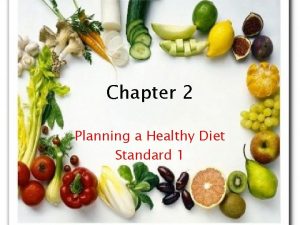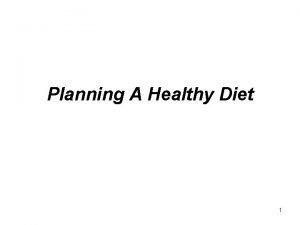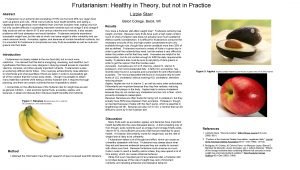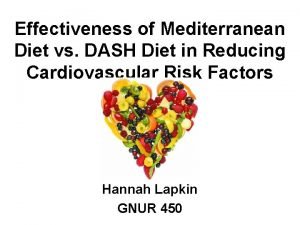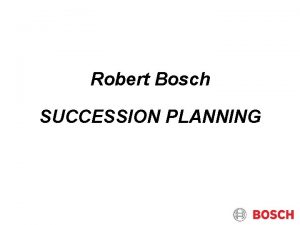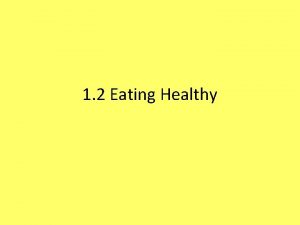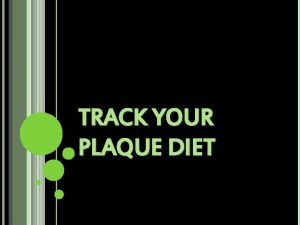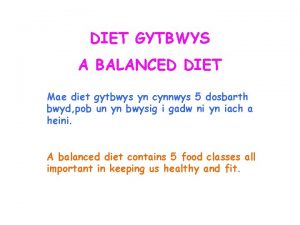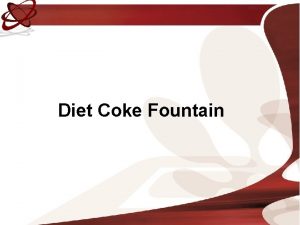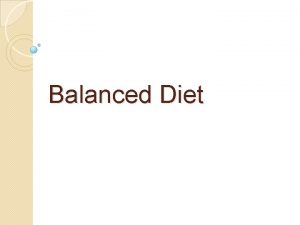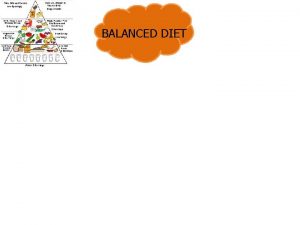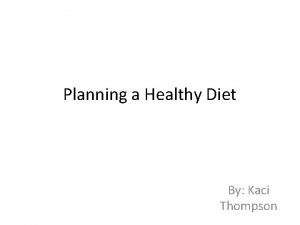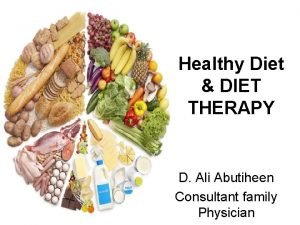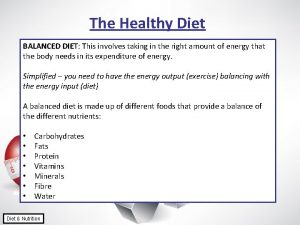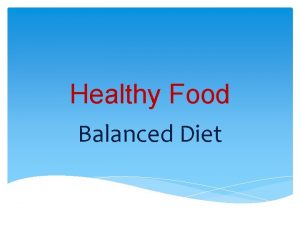Planning A Healthy Diet 1 Diet Planning Principles

















- Slides: 17

Planning A Healthy Diet 1

Diet Planning Principles ü Adequate ü Balanced ü Energy controlled ü Nutrient dense ü Moderation ü Variety 2

Adequate ü Providing all the essential nutrients, fiber, and energy in amounts sufficient to maintain health. 3

Balanced ü Providing foods of a number of types in proportion to each other, such that foods rich in some nutrients do not crowd out of the diet foods that are rich in other nutrients ü Balance helps to ensure adequacy. 4

Energy Controlled ü Management of food energy intake to maintain a healthy weight 5

Nutrient Dense ü A measure of the nutrients a food provides relative to the energy it provides. The more nutrients and fewer calories, the higher the nutrient density. ü “Empty Calories” refers to foods which provide calories but lack any nutrients, such as candy or soda. 6

Moderation ü Providing enough but not too much of a substance 7

Variety ü Eating a wide selection of foods within and among the major food groups ü Helps achieve adequacy 8

Daily Food Guide ü Developed by the USDA ü A pictorial representation of the Daily Food Guide, The Food Guide Pyramid ü Assigns foods to the five major food groups ü Lists the number of servings recommended 9

Daily Food Guide {continued} ü Lists the most notable nutrients of each group ü Lists the serving sizes ü Lists the foods within each group categorized by nutrient density 10

Exchange Lists For Meal Planning ü Diet planning tools that organize foods by their proportions of carbohydrate, fat, and protein ü Foods on any single list can be used interchangeably ü Helps control energy intake by emphasizing portion sizes 11

Food Labels ü Ingredient list ü Serving size ü Nutrition facts ü The daily values 12

Ingredient List ü All ingredients must be listed in order of predominence by weight. 13

Serving Size ü Labels present nutrient information per serving, thus a serving size must be identified. ü Serving sizes reflect amounts that people commonly consume. 14

Nutrition Facts ü Total calories ü Fat calories ü Total fat grams ü Saturated fat grams ü Cholesterol milligrams ü Sodium milligrams ü Total carbohydrate including : starch, sugar, and fiber grams ü Protein grams ü Vitamins A and C ü Minerals, iron and calcim 15

The Daily Values ü Reference values developed by the FDA specifically for use on foods labels ü Reflect dietary recommendations for nutrients based on a 2000 calorie diet ü Provide a ballpark estimate of how individual foods contribute to the total diet 16

Eating And Oral Health ü Both sugars and starch begin breaking down to sugars in the mouth and can contribute to tooth decay. ü Bacteria in the mouth ferment the sugars which results in formation of an acid that can dissolve tooth enamel. 17
 Chapter 2 planning a healthy diet
Chapter 2 planning a healthy diet Diet planning principles
Diet planning principles Nutrition and productivity
Nutrition and productivity Healthy soil healthy life poster ideas
Healthy soil healthy life poster ideas Healthy forests healthy communities poster contest
Healthy forests healthy communities poster contest Healthy nurse healthy nation
Healthy nurse healthy nation Is fruitarian diet healthy
Is fruitarian diet healthy Dash diet vs mediterranean diet
Dash diet vs mediterranean diet Principles of succession planning
Principles of succession planning Menu planning principles
Menu planning principles Principles of planning
Principles of planning Gross rating points
Gross rating points Principles of effective planning
Principles of effective planning Land and environment court planning principles
Land and environment court planning principles Strategic planning vs tactical planning
Strategic planning vs tactical planning Goal achievement matrix
Goal achievement matrix Scenario planning workforce planning
Scenario planning workforce planning Inactivism planning
Inactivism planning
